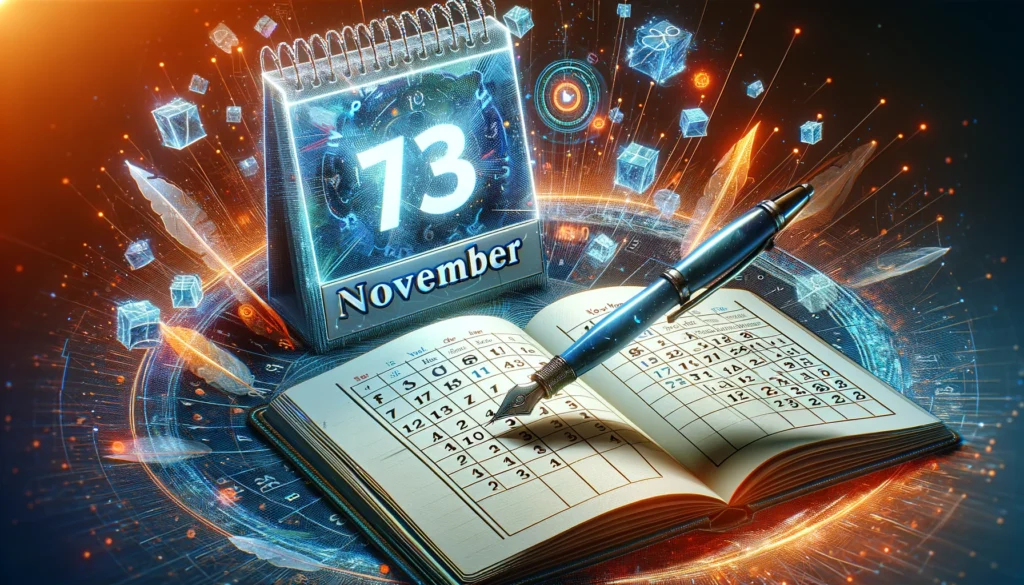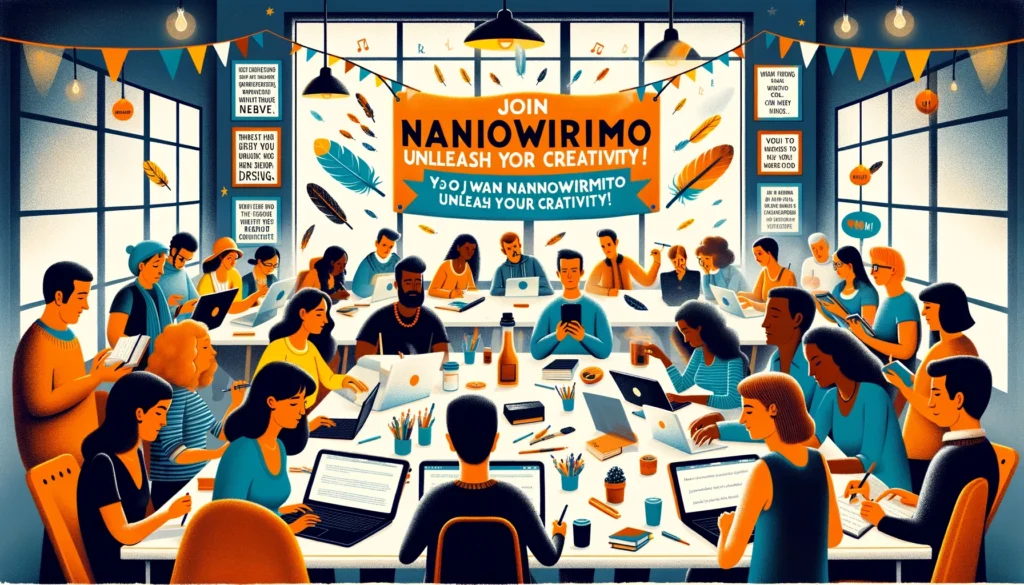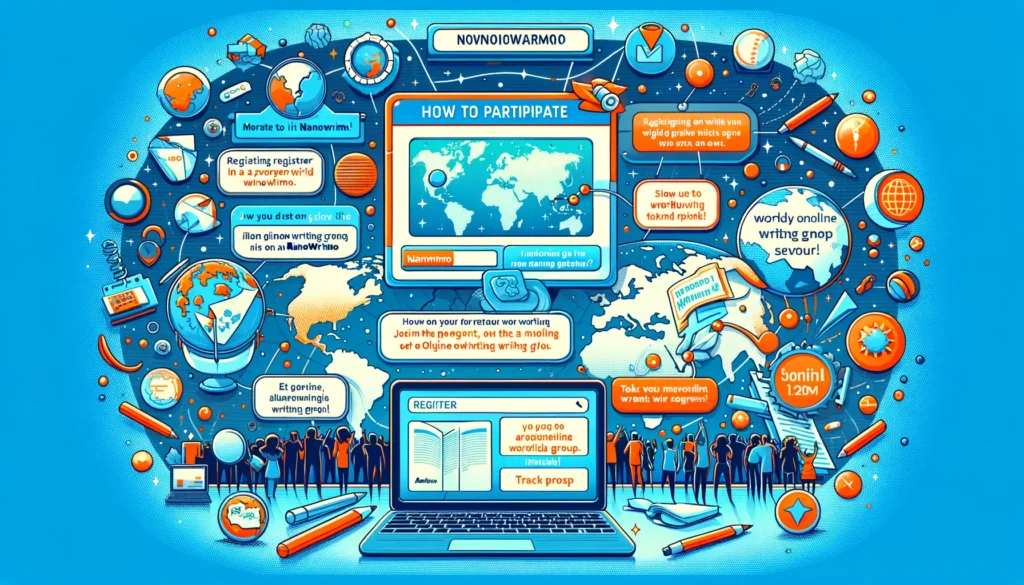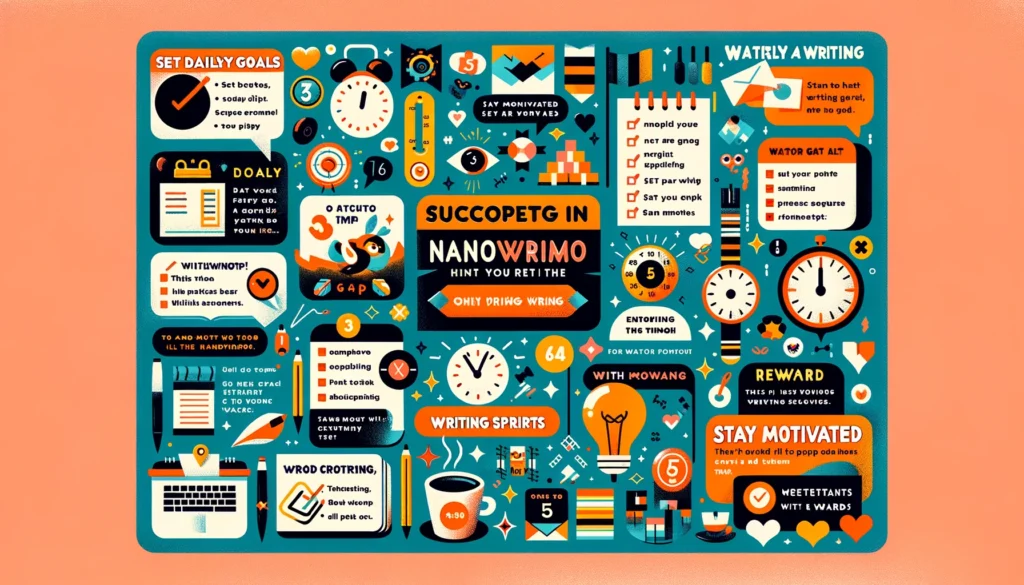Ever wondered what does NaNoWriMo stand for? NaNoWriMo, or National Novel Writing Month, is an annual challenge that encourages people to write a novel in just one month.
Writing a whole novel in November? That’s the goal. But it’s also about joining a community of writers who are all in it together, supporting and pushing each other to reach their personal best.
So, whether you’re a seasoned writer or someone looking to dip their toes into the world of writing for the first time, NaNoWriMo offers the perfect opportunity. It’s a chance to challenge yourself, explore new ideas, and maybe even surprise yourself with what you can accomplish when you set your mind to it.
What Does NaNoWriMo Stand For?

NaNoWriMo stands for National Novel Writing Month. It’s an event that happens every November, where people from all over the world challenge themselves to write a 50,000-word novel in just 30 days.
The idea started back in 1999 with a small group of friends in San Francisco and has since grown into a global phenomenon, inspiring hundreds of thousands of writers to put pen to paper, or fingers to keyboard.
The goal of NaNoWriMo isn’t just to write a novel. It’s to spark creativity, build writing habits, and push past the inner critic that tells so many of us we can’t do it. It’s about the process, not the final product.
Whether you end up with a polished novel or a rough first draft, the real win is the discipline you develop along the way.
NaNoWriMo also has a large community of writers. Through its website and local events, participants can support, encouragement, and inspire each other. This sense of community is a huge part of what makes NaNoWriMo special. Writers share their progress, struggles, and successes, making the daunting task of writing a novel feel a little less lonely.
What are the rules for NaNoWriMo

The rules for NaNoWriMo are pretty straightforward and they focus on encouraging writers to just write. Here’s the rundown:
- Write 50,000 Words: The primary goal is to write a 50,000-word novel from scratch starting on November 1st and finishing by 11:59 PM on November 30th. It’s about hitting that word count by the end of the month, no matter what it takes.
- Start Fresh: Ideally, you should begin with a brand new idea. While planning and outlining your novel before November is allowed (and encouraged!), actual prose writing should not start until November 1st.
- It’s Your Word Count That Counts: The only thing that really matters is the word count. It doesn’t matter if what you’re writing isn’t polished or even if it makes perfect sense. The aim is to get those words down first. You can always edit later.
- Any Genre, Any Language: There are no restrictions on genre. Whether you’re into romance, sci-fi, mystery, or something else, all that counts is writing a novel in the language of your choice.
- Verification: To officially “win” NaNoWriMo, you need to verify your word count on the NaNoWriMo website by the end of the month. There’s a tool on the site where you can upload your novel to check the word count. Don’t worry; the text isn’t saved or stored on the website—it’s just to confirm you’ve hit the goal.
- Solo Effort: While NaNoWriMo emphasizes community and support, your novel should be your own work. Collaborations are fun but don’t fit the traditional NaNoWriMo challenge.
- Have Fun and Stay Positive: Perhaps the most important rule is to enjoy the process. NaNoWriMo is about challenging yourself, meeting new friends, and celebrating your love of writing. It’s a chance to push your limits in a supportive environment.
Remember, NaNoWriMo is more about the effort and less about perfection. It’s a unique opportunity to focus intensely on your writing, with a clear goal and a deadline to work toward, surrounded by a global community of fellow writers doing the same.
Why Should You Participate in NaNoWriMo

Joining NaNoWriMo might seem like a huge task, but there are so many good reasons to give it a try.
First off, it’s a fantastic push to finally start that novel you’ve been thinking about. Sometimes, all we need is a little nudge to turn our ideas into actual words on a page, and NaNoWriMo is exactly that. It sets a clear goal and deadline, which can be incredibly motivating.
Another great reason is the community. Writing can be a lonely activity, but during NaNoWriMo, you’ll find yourself part of a massive group of people who are all working towards the same goal. There’s something really special about that. You can share your progress, get advice, and support each other through the ups and downs.
NaNoWriMo also teaches you about your own writing process. By pushing you to write every day, you learn what works best for you, how to overcome writer’s block, and how to keep going even when it’s tough.
Lastly, it’s just really satisfying to challenge yourself. Even if you don’t hit the 50,000-word target, you’ll likely write more than you would have otherwise.
And if you do reach that goal, the sense of achievement is incredible. You’ll have started the journey of writing a novel, and that’s a big deal. So, why not give it a shot? You might surprise yourself with what you can accomplish.
How to Prepare for NaNoWriMo

Getting ready for NaNoWriMo can make a big difference in how smoothly your month goes. Here’s how to gear up for this writing adventure:
First, think about what you want to write. Having a clear idea or even a basic outline of your story can help a lot.
You don’t need every detail figured out, but knowing your main characters, setting, and the plot’s direction can give you a solid starting point.
Spend some time jotting down your ideas, sketching out character profiles, or outlining your plot.
Next, set up a writing space. Find a spot where you feel comfortable and can focus, free from distractions.
It could be a corner of your room, a local café, or anywhere you find inspiration. Make sure you have everything you need, like your laptop, notebook, pens, or any other tools that help you write.
Then, plan your writing schedule. NaNoWriMo is all about consistency. Look at your calendar and figure out when you can write each day.
Some people aim for a specific word count daily, while others might have more time on weekends. Find what works for you and stick to it as best as you can.
It’s also a good idea to let your friends and family know what you’re up to. They can offer support and understand when you need some space to focus on writing.
Lastly, join the NaNoWriMo community online. Sign up on the NaNoWriMo website, check out forums, and maybe even find local writing groups. This community can be a huge source of motivation and advice.
Remember, the goal is to write, not to write perfectly. Preparing for NaNoWriMo is about setting yourself up for success, but also about getting ready to embrace the challenge and have fun with your writing.
How to Participate for NaNoWriMo

Participating in NaNoWriMo is a straightforward process. Here’s how to dive in:
- Sign Up: Start by visiting the official NaNoWriMo website. Signing up is free, and it gives you access to a wealth of resources. You’ll get to track your progress, connect with other writers, and find lots of encouragement.
- Set Up Your Profile: Once you’re signed up, take a moment to set up your profile. You can add information about yourself, your writing interests, and the novel you plan to write. This step isn’t just about filling out forms; it’s your first step in committing to your November writing journey.
- Announce Your Novel: On the NaNoWriMo site, you’ll have the opportunity to announce your novel. This means giving it a title (even if it’s a working title) and a brief synopsis. Putting your novel out there makes your commitment feel more real, and it’s a great way to start getting excited about your project.
- Find Your Community: NaNoWriMo is as much about community as it is about writing. Look for local or virtual “write-ins” where you can meet other participants. The forums on the NaNoWriMo website are also a fantastic place to share experiences, tips, and encouragement.
- Start Writing: When November 1st rolls around, it’s time to start writing. Remember, the goal is to write 50,000 words by the end of the month. How you reach that goal is up to you. Some people plan extensively, while others dive in with a more spontaneous approach.
- Update Your Progress: As you write, you can update your word count on the NaNoWriMo website. Watching your progress bar grow is incredibly satisfying and helps keep you motivated.
- Engage With the Community: Throughout the month, engage with the NaNoWriMo community. Participate in challenges, attend events, and share your progress. The support and encouragement you’ll find can make a huge difference, especially on tough days.
- Cross the Finish Line: If you reach 50,000 words by November 30th, you can upload your novel to the NaNoWriMo website for official verification. Winning NaNoWriMo means you’ve met your word count goal, but remember, every word you write is a victory.
Participating in NaNoWriMo is about setting a goal and challenging yourself to meet it, but it’s also about joining a global community of writers all working toward the same goal. It’s a unique experience that can push you to learn more about yourself as a writer.
Tips for Participating in NaNoWriMo

Participating in NaNoWriMo is an exciting challenge. Here are some tips to help you make the most of it:
- Plan Ahead: Even if you’re not a planner by nature, having a rough idea of your story can help. Know your main characters and the central conflict before November starts. This doesn’t mean you need a detailed outline, but a basic roadmap can keep you moving forward.
- Set Daily Goals: The target is 50,000 words in a month, which breaks down to about 1,667 words a day. Setting daily word count goals can help keep you on track. Don’t worry if you miss a day; just try to catch up when you can.
- Create a Routine: Find a writing routine that works for you. Some people write best in the morning, while others prefer the night. Consistency can help you build momentum, making it easier to hit your daily targets.
- Stay Flexible: While having a plan is helpful, don’t be afraid to deviate from it. New ideas will come to you as you write. Embrace these surprises; they can lead your story in exciting new directions.
- Connect with Other Writers: NaNoWriMo is a communal event. Engaging with the community can provide motivation and support. Join forums, attend virtual write-ins, and share your experiences with fellow participants.
- Take Care of Yourself: Remember to take breaks, stay hydrated, and get enough rest. Writing a novel in a month is a marathon, not a sprint. Taking care of your physical and mental health is crucial.
- Embrace Imperfection: Your NaNoWriMo draft doesn’t have to be perfect. In fact, it won’t be. The goal is to get the words down. You can always revise and edit later.
- Celebrate Your Progress: Every word you write is an achievement. Celebrate your milestones, whether it’s hitting your daily word count or completing a pivotal scene. Recognize your hard work and use it as motivation to keep going.
How to Win NaNoWriMo

Winning NaNoWriMo is about crossing that 50,000-word finish line within the month of November. But what does it really take to get there, beyond just tallying up words? It’s about dedication, flexibility, and a bit of strategy.
Firstly, winning starts with commitment. You’ve got to be all in, deciding that no matter what, you’re going to make writing a priority for this one month.
It means finding time every day to write, whether that’s waking up earlier, cutting down on TV time, or using lunch breaks to type out a few hundred words.
Then, there’s the aspect of flexibility. Some days you’ll exceed your word count goals, and others, you might not write at all. That’s okay. The key is not to get discouraged.
If you fall behind, adjust your daily goals to catch up gradually. And if you’re on a roll, take advantage to get ahead on your word count.
Another crucial part of winning is to let go of perfectionism. This challenge is about getting the story out of your head and onto the page.
There will be plenty of time to edit and revise after November. During NaNoWriMo, your best tool is a willingness to write without self-censorship.
Engaging with the NaNoWriMo community can also be a game-changer. Sharing your progress, challenges, and successes with others who understand what you’re going through can provide a significant boost. Plus, seeing others reach their goals can be incredibly motivating.
Finally, remember why you started. There will be moments when you question if it’s worth it, but keep in mind your reasons for joining NaNoWriMo.
Whether it’s to prove to yourself that you can do it, to finally start that novel that’s been in your head for years, or simply for the love of writing, keeping your goal in sight can help carry you through to the end.
Winning NaNoWriMo is a personal victory. It’s proof of what you can achieve with dedication and effort. And when you hit that 50,000-word mark, it’s a celebration of your commitment to your writing and to yourself.
Conclusion
Understanding what does NaNoWriMo stand for goes beyond just decoding its acronym; it’s about recognizing the event as discipline in writing. This annual challenge not only pushes aspiring writers to embark on a novel-writing journey but also fosters a sense of community among participants from diverse backgrounds.
It’s a time when writers can put their ideas to the test, learn more about their writing process, and, most importantly, prove to themselves that writing a novel in a month is indeed possible with perseverance and support.Whether you reach the 50,000-word goal or not, the experience is invaluable. It offers lessons in dedication, time management, and the art of writing itself, making the question of what does NaNoWriMo stand for resonate with personal growth and achievement in the world of writing.
FAQ
Is NaNoWriMo free?
Yes, NaNoWriMo is completely free to participate in. Anyone interested in writing can sign up on the NaNoWriMo website and take part in the challenge without any cost. The organization behind NaNoWriMo is non-profit and relies on donations to keep running, but there’s no fee required to join the writing adventure.
What happens if you win NaNoWriMo?
Winning NaNoWriMo means you’ve successfully written 50,000 words of your novel in November. Winners receive a certificate of achievement, special offers from NaNoWriMo sponsors, including discounts on writing software, and the satisfaction of knowing they’ve accomplished a significant writing milestone. It’s a personal victory that signifies your dedication and hard work.
Is NaNoWriMo still a thing?
Yes, NaNoWriMo is very much still a thing. It has grown significantly since its inception in 1999, with thousands of writers from around the world participating each year. The event continues to inspire and support writers in achieving their goal of writing a novel in November.
Why is NaNoWriMo 50,000 words?
The 50,000-word goal for NaNoWriMo is based on the length of a short novel. It’s considered a challenging yet achievable target for most people to reach within a month, making it an ideal benchmark for the event. This word count encourages participants to focus on progress and consistency rather than perfection.
Can you swear in NaNoWriMo?
Yes, you can include swear words in your NaNoWriMo project. The content of your novel is entirely up to you. NaNoWriMo doesn’t impose restrictions on language, themes, or subject matter, allowing writers the creative freedom to express their story as they see fit.
Is NaNoWriMo worth it?
Participating in NaNoWriMo is considered worth it by many writers for various reasons, including the opportunity to challenge oneself, the experience of joining a supportive community, and the accomplishment of making significant progress on a novel. It’s a unique way to dedicate time to your writing and potentially kickstart a larger project.
What happens if you don’t finish NaNoWriMo?
If you don’t finish NaNoWriMo, nothing negative happens. Many participants don’t reach the 50,000-word goal, but they still benefit from having written more than they might have otherwise. The process is a learning experience, and any words written are a step forward in your writing journey.
Is NaNoWriMo just for kids?
No, NaNoWriMo is for writers of all ages. While it’s open to adults, there’s also a Young Writers Program specifically designed for writers under 18. This ensures that writers of any age can participate in a way that’s suitable for them, making NaNoWriMo a truly inclusive event.
Does NaNoWriMo have an age limit?
There’s no upper age limit for participating in NaNoWriMo. The event welcomes writers of all ages, from teenagers to seniors. For younger writers, the NaNoWriMo Young Writers Program provides age-appropriate resources and support.
